Latin America Residential Real Estate Market Size
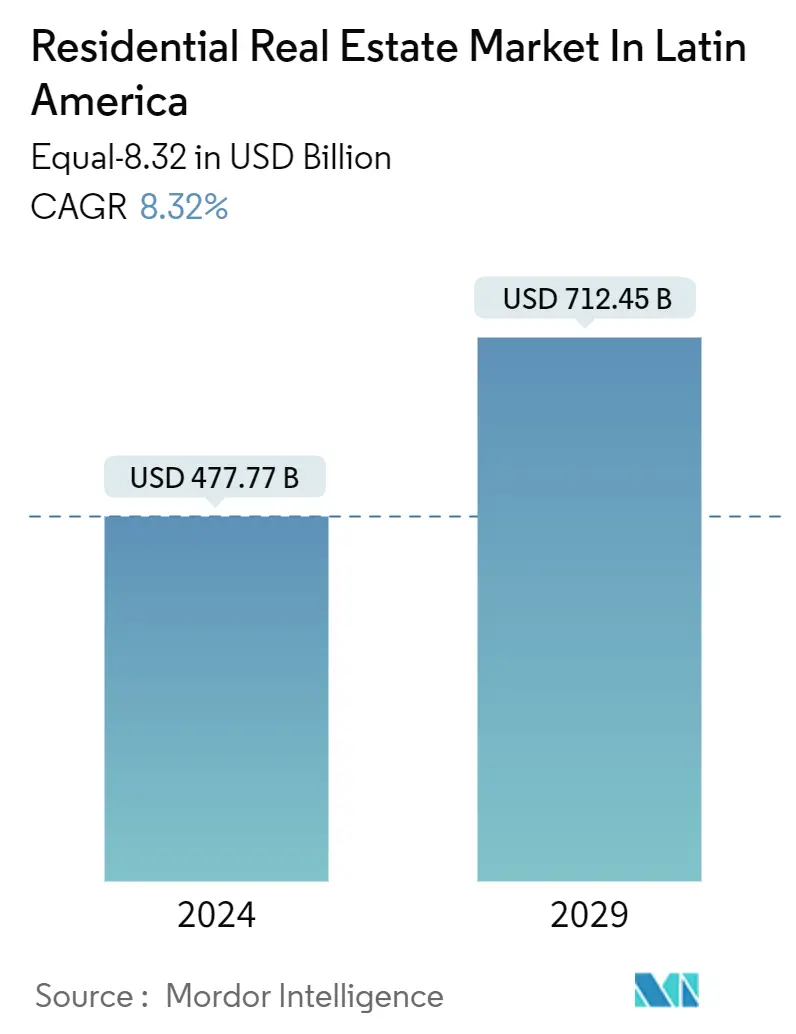
| Study Period | 2020 - 2029 |
| Base Year For Estimation | 2023 |
| Market Size (2024) | USD 477.77 Billion |
| Market Size (2029) | USD 712.45 Billion |
| CAGR (2024 - 2029) | 8.32 % |
| Market Concentration | Low |
Major Players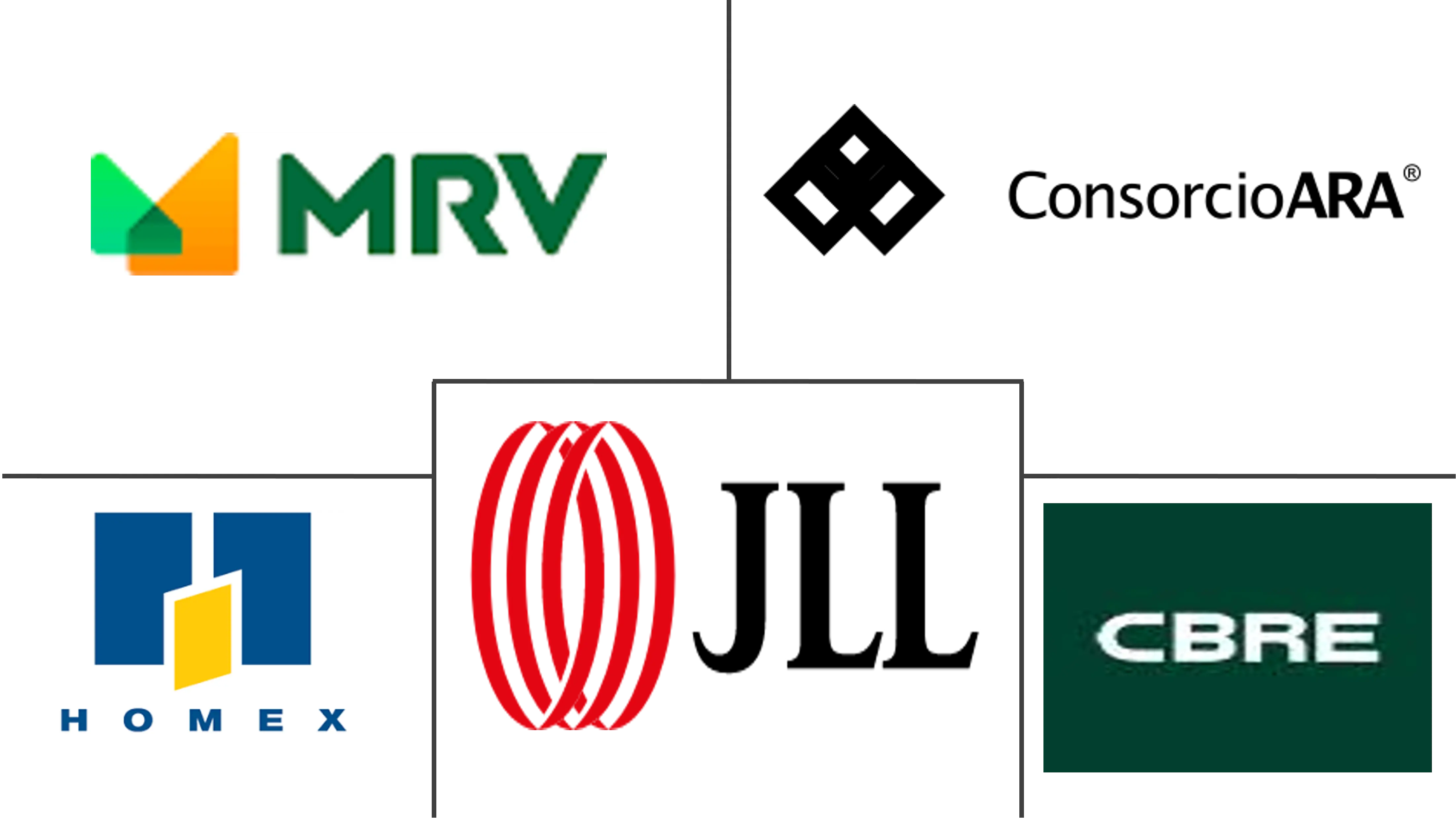
*Disclaimer: Major Players sorted in no particular order |
Need a report that reflects how COVID-19 has impacted this market and its growth?
Latin America Residential Real Estate Market Analysis
The Residential Real Estate Market In Latin America Industry in terms of Equal-8.32 is expected to grow from USD 477.77 billion in 2024 to USD 712.45 billion by 2029, at a CAGR of 8.32% during the forecast period (2024-2029).
- The market is driven by increased urbanization and a burgeoning middle class. The COVID-19 pandemic impacted the Latin American residential real estate market significantly, with the economic slowdown and increased investor uncertainty serving to dampen growth in the short term. However, the pandemic has stimulated demand for rental properties and accommodation with outdoor space, accelerated the digitalization of the industry, and boosted competition among mortgage lenders.
- South American countries grapple with the familiar challenge of housing affordability, particularly in their urban centers. In 2022, it took an average-income household in Lima, Peru, nearly 19 years to buy a home, while in cities like Buenos Aires, Bogota, and Rio de Janeiro, this stretched to around 30 years. Roughly a quarter of Peruvians opt for renting, a figure that likely surges in major cities like Lima. Renting is notably prevalent in Colombia, with over 40% of homes in several departments being rentals. Bogota, Colombia's capital, emerged as the most lucrative city for rental investments in South America, closely followed by Santiago, Chile.
- Residential real estate prices exhibit significant disparities across and within cities. In 2022, Puerta Madero, located in Buenos Aires, Argentina, emerged as South America's priciest neighborhood for apartment purchases, with an average square meter price nearing USD 6,000. However, Buenos Aires boasted several neighborhoods where apartment prices dipped below USD 2,000. In the city's central region, encompassing San Nicolas and Montserrat, apartment prices ranged from USD 1,700 to USD 1,800 per square meter.
- In September 2023, Montevideo, the capital of Uruguay, emerged as the priciest real estate market in Latin America, commanding an average selling price of USD 3,166 per square meter for apartments. Mexico City, the capital of Mexico, secured the second spot with a price tag of USD 2,948 per square meter. Moreover, as the production and consumption of residential real estate continue to surge, they are poised to fuel the growing appetite among consumers.
Latin America Residential Real Estate Market Trends
Increase in Urbanization Boosting Demand for Residential Real Estate
- Latin America's economies span a spectrum, from emerging powerhouses like Mexico and Brazil to more established players like Chile and Uruguay. This diversity presents investors with a range of real estate opportunities tailored to their risk appetite and investment goals. Moreover, Latin America boasts one of the world's highest urbanization rates, fueling a surge in demand for both residential and commercial properties.
- The economic growth in Latin America is underpinning this real estate boom. For instance, the Brazilian economy is projected to grow by 2% this year, while Mexico is expected to register a growth rate of 1.8% to 2.5%. This economic expansion is translating into job creation and higher disposable incomes, further bolstering the demand for real estate.
- With a population of around 665 million in 2023, Latin America witnessed a 0.9% population growth in 2022. This uptick was driven by a trend of people gravitating toward urban areas in search of better education and employment prospects. As the urban population swells, so does the demand for residential properties in Latin American cities. Notably, some governments in the region are actively promoting pro-poor urban infrastructure, with a particular focus on housing initiatives.
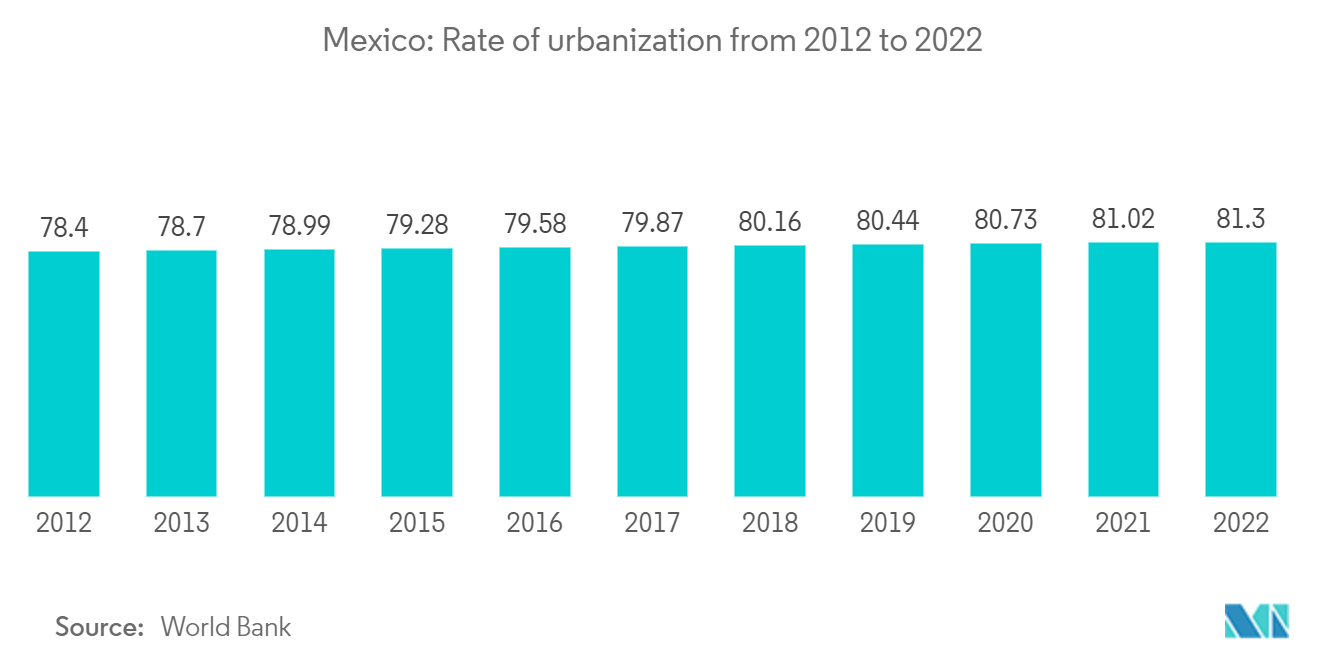
Increase in Apartments and Condominiums Property Prices in Mexico is Boosting the Market
- In 2023, Mexico City emerged as the costliest destination for residential property purchases in Mexico. The average price for a property in the nation's capital stood at nearly MXN 3.7 million (USD 0.19 million) in Q3 2023, nearly twice the national average.
- According to the Federal Mortgage Society (FMS), the average home price in Mexico hit USD 90,850 in Q1 2023, marking an 11.7% YoY surge. The Mexican housing market, known for its adaptability to global economic shifts, has witnessed consistent growth over the past decade. The robust Q1 growth underscores the market's resilience. Escalating inflation has further pushed up construction costs, leading to a steeper hike in prices for new builds, which constitute 40% of the Mexican housing market, surging by 12.8%.
- Investors eyeing Mexico, especially the Riviera Maya, have reason to be optimistic. The bullish trend in 2023 underscored the strength and potential of Mexico's real estate sector. With sustained demand and robust economic growth projected, regions like Riviera Maya are poised to fuel Mexico's upward housing market trajectory, offering enticing opportunities for investors and homeowners.
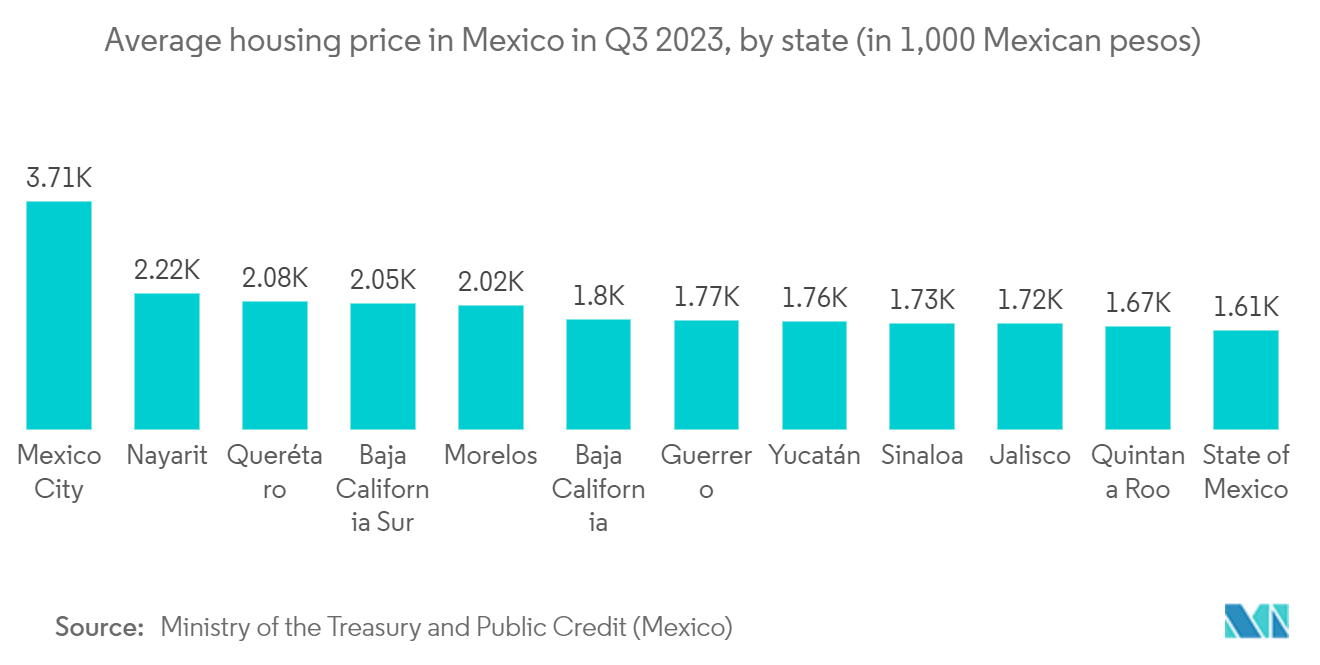
Latin America Residential Real Estate Industry Overview
The Latin American residential real estate market is competitive and fragmented, with the presence of regional and international players. Major companies in the market have adopted strategies such as acquisition, business development, joint ventures, partnerships, and product launches to offer better services to customers in the residential real estate market. The major players include JLL, CBRE, Mrv Engenharia e Participacoes SA, Homex, and Consorcio ARA.
Latin America Residential Real Estate Market Leaders
JLL
CBRE
Mrv Engenharia e Participacoes S/A
Homex
Consorcio ARA
*Disclaimer: Major Players sorted in no particular order
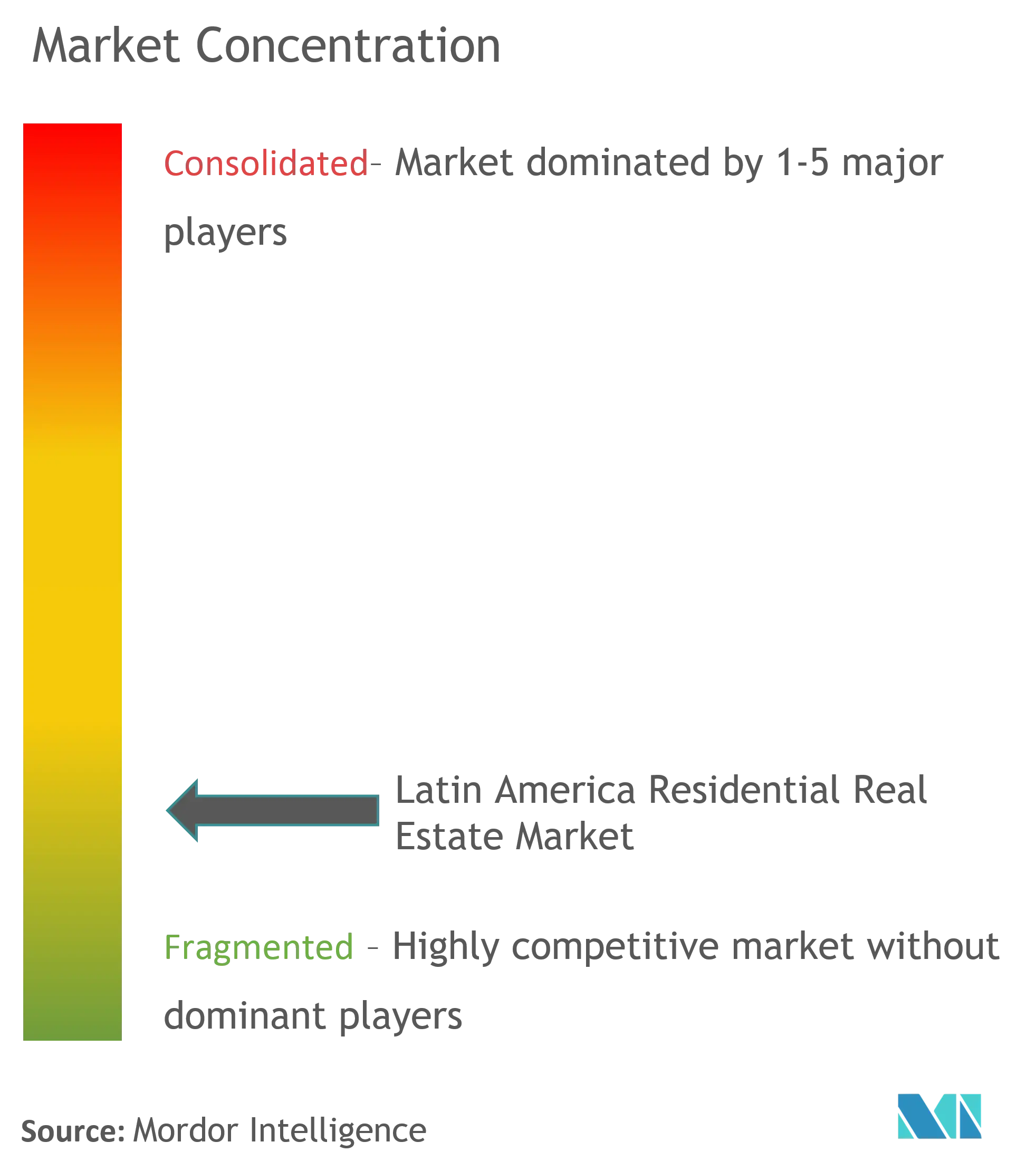
Latin America Residential Real Estate Market News
- November 2023: CBRE, a prominent global consultancy and real estate services firm, unveiled its latest initiative, the Latam-Iberia platform. The platform's primary goal is to reinvigorate the real estate markets in Europe and Latin America while fostering investment ties between the two regions. By enhancing business collaborations and amplifying the visibility of real estate solutions, CBRE aims to catalyze growth in the sector.
- May 2023: CJ do Brasil, a subsidiary of multinational firm CJ Bio, completed its USD 57 million plant expansion in Piracicaba, 160 km from Brazil's capital. CJ Bio is renowned for its expertise in amino acid production. The expansion is projected to create 650 new job opportunities, and the investment also encompasses the establishment of residential, research, and development centers.
Latin America Residential Real Estate Market Report - Table of Contents
1. INTRODUCTION
1.1 Study Assumptions
1.2 Scope of the Study
2. RESEARCH METHODOLOGY
2.1 Analysis Methodology
2.2 Research Phases
3. EXECUTIVE SUMMARY
4. MARKET INSIGHTS AND DYNAMICS
4.1 Current Market Scenario
4.2 Residential Real Estate Buying Trends - Socioeconomic and Demographic Insights
4.3 Government Initiatives and Regulatory Aspects Pertaining to the Residential Real Estate Sector
4.4 Insights into the Size of Real Estate Lending and Loan-to-value Trends
4.5 Insights into the Interest Rates for the General Economy and Real Estate Lending
4.6 Insights into the Rental Yields in the Residential Real Estate Sector
4.7 Impact of COVID-19 on the Market
5. MARKET DYNAMICS
5.1 Market Drivers
5.1.1 Increase in Population is Boosting the Residential Real Estate Market
5.1.2 Rapid Growth in Urbanization
5.2 Market Restraints
5.2.1 Accelerated Increase in Construction Costs
5.3 Market Opportunities
5.3.1 Proptech in the Real Estate
5.4 Industry Attractiveness - Porter's Five Forces Analysis
5.4.1 Bargaining Power of Suppliers
5.4.2 Bargaining Power of Consumers / Buyers
5.4.3 Threat of New Entrants
5.4.4 Threat of Substitute Products
5.4.5 Intensity of Competitive Rivalry
6. MARKET SEGMENTATION
6.1 By Type
6.1.1 Apartments and Condominiums
6.1.2 Landed Houses and Villas
6.2 By Geography
6.2.1 Mexico
6.2.2 Brazil
6.2.3 Colombia
6.2.4 Rest of Latin America
7. COMPETITIVE LANDSCAPE
7.1 Overview
7.2 Company Profiles
7.2.1 JLL
7.2.2 CBRE
7.2.3 Mrv Engenharia e Participacoes SA
7.2.4 HomeX
7.2.5 Consorcio ARA
7.2.6 Cyrela
7.2.7 Multiplan Real Estate Asset Management
7.2.8 Groupe CARSO
7.2.9 Grupo Sadasi
7.2.10 Bmx Realizacoes Imobiliarias e Participacoes SA*
- *List Not Exhaustive
7.3 Other Companies
8. MARKET OPPORTUNITIES AND FUTURE TRENDS
9. APPENDIX
9.1 Marcroeconomic Indicators (GDP Breakdown by Sector, Contribution of Construction to Economy, etc.)
9.2 Key Production, Consumption, and Export and Import Statistics of Construction Materials
Latin America Residential Real Estate Industry Segmentation
Homes or apartments are residential properties. These may include single-family homes, townhouses, or studios. Most residential property owners who own residential property but do not live there will rent it to others to make money from the property.
The report provides a comprehensive background analysis of the market, covering the current market trends, restraints, technological updates, and detailed information on various segments and the competitive landscape of the industry. The report on the Latin American residential real estate market is segmented by type (apartments and condominiums and landed houses and villas) and geography (Mexico, Brazil, Colombia, and the Rest of Latin America).
The report offers the market sizes and forecasts for the Latin American residential real estate market in value (USD) for all the above segments.
| By Type | |
| Apartments and Condominiums | |
| Landed Houses and Villas |
| By Geography | |
| Mexico | |
| Brazil | |
| Colombia | |
| Rest of Latin America |
Latin America Residential Real Estate Market Research FAQs
How big is the Residential Real Estate Market In Latin America Industry?
The Residential Real Estate Market In Latin America Industry size is expected to reach USD 477.77 billion in 2024 and grow at a CAGR of 8.32% to reach USD 712.45 billion by 2029.
What is the current Residential Real Estate Market In Latin America Industry size?
In 2024, the Residential Real Estate Market In Latin America Industry size is expected to reach USD 477.77 billion.
Who are the key players in Residential Real Estate Market In Latin America Industry?
JLL, CBRE, Mrv Engenharia e Participacoes S/A, Homex and Consorcio ARA are the major companies operating in the Residential Real Estate Market In Latin America Industry.
What years does this Residential Real Estate Market In Latin America Industry cover, and what was the market size in 2023?
In 2023, the Residential Real Estate Market In Latin America Industry size was estimated at USD 438.02 billion. The report covers the Residential Real Estate Market In Latin America Industry historical market size for years: 2020, 2021, 2022 and 2023. The report also forecasts the Residential Real Estate Market In Latin America Industry size for years: 2024, 2025, 2026, 2027, 2028 and 2029.
Latin America Residential Real Estate Industry Report
Statistics for the 2024 Residential Real Estate in Latin America market share, size and revenue growth rate, created by Mordor Intelligence™ Industry Reports. Residential Real Estate in Latin America analysis includes a market forecast outlook to for 2024 to 2029 and historical overview. Get a sample of this industry analysis as a free report PDF download.
